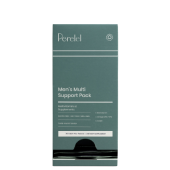Once you’ve had time to properly bask in the excitement of a positive pregnancy test, you may start to wonder what the next 40 weeks will bring. How do you calculate your due date? What’s the best way to support your baby’s development? And when, exactly, will those weird cravings kick in? Here’s what to expect at each stage of your pregnancy.

How to Calculate your Due Date
The average pregnancy lasts 40 weeks. Those weeks are broken up into three trimesters:
- First Trimester (0 to 12 weeks)
- Second Trimester (13 to 28 weeks)
- Third Trimester (29 to 40 weeks)1
In order to figure out how far along you are—and all the life changes you can expect at each stage of pregnancy—first you’ll need to calculate your due date.
When measuring pregnancy progress, “Week 0” begins with the first day of your last menstrual period. So if you know that date, you can count ahead 40 weeks to estimate your baby’s due date.
Your date of conception is actually the first day of “Week 2.” Count ahead 38 weeks from this date to estimate your due date.
If you’re too tired to do the math (Hey, that first trimester fatigue is no joke!) you can plug your last period or conception date into Perelel's handy due date calculator here.
If you conceived through IVF, you can use the due date calculator at Reproductive Medicine Associates to calculate your due date based on your date and type of embryo transfer.
First Trimester
YOUR BABY’S DEVELOPMENT:
The first trimester officially starts with your last menstrual period. But after fertilization, things kick into high gear pretty quickly.
According to USCF Health, the first trimester of pregnancy is “the most crucial to your baby’s development.”2 This is when your baby starts to develop their brain, spinal cord, heart, and other organs. That also means it’s the stage of pregnancy when most miscarriages and birth defects happen.
HOW YOU’RE FEELING:
You’ll notice some changes to your body, which may be the first clue to your pregnancy. Symptoms of early pregnancy include breast tenderness, fatigue, and frequent urination.
You may also experience nausea or vomiting. While this is commonly called “morning sickness,” it may happen at any time of day.
PRENATAL CARE:
After you find out you’re pregnant, it’s important to start prenatal care as early as possible.
First trimester care starts with an initial visit to your OB/GYN, who will typically recommend screening tests to assess your health and your baby’s health. You may also get an early pregnancy ultrasound to estimate the baby’s due date and check for abnormalities.
Prenatal care also means adjusting your nutrition to support a healthy pregnancy. “Eating for two? Your daily quota of fruits and veggies, complex carbs, and protein increases by about 300 calories3, so keep the categories balanced,” says Kimberly Langdon, MD, an OB/GYN with the online medical service Medzino.
And if you’re not already taking one, now’s the time to start taking prenatal vitamins. Perelel’s 1st Trimester Prenatal Pack includes:
- A no-nausea Core Prenatal that provides key nutrients you need during this stage of pregnancy, including folate and choline to help support your baby’s neurodevelopment
- An Omega DHA+EPA capsule to support brain development
- An additional folate capsule to support neural development
- A B6 + Ginger capsule for anti-nausea support
There are also certain foods you should avoid during early pregnancy—including unpasteurized dairy products, high-mercury fish, and alcohol.
Second Trimester

YOUR BABY’S DEVELOPMENT:
Your baby goes through a pretty dramatic growth spurt during the second trimester — from the size of a lemon at 13 weeks to the size of a head of lettuce at 28 weeks.4
During this stage of pregnancy, your baby’s nervous system starts to function. Facial features, hair, fingernails, and reproductive organs are all developing.5
Around 20 weeks—the official halfway point of your pregnancy—you may also start to feel the first flutters of movement.6
HOW YOU’RE FEELING:
The second trimester is a sigh of relief for many women. Some of the most unpleasant symptoms from the first trimester will likely start to subside, and you may find you’re sleeping better and feeling more energetic.
But as your bump grows, your body will go through some pretty significant transformations of its own to support this new life. You may experience back pain, abdominal pain, leg cramps, constipation, and heartburn.
PRENATAL CARE:
Around the 18 to 20-week mark, you’ll have an ultrasound to check your baby’s development. If you wish to learn your baby’s gender, this is when you’ll typically find out, though some tests may determine it sooner. Your doctor may also recommend a genetic screening test or nuchal translucency (NT) test if needed.
A glucose challenge test is given near the end of the second trimester. You’ll guzzle a sugary drink, then your doctor will monitor your blood glucose level to gauge your risk of developing gestational diabetes.
During the second trimester, it’s important to continue to eat a balanced diet that provides a variety of nutrients. That should include fruits, vegetables, protein foods, whole grains, and low-fat dairy products.7
You should also continue taking prenatal vitamins throughout your second trimester. Perelel’s 2nd Trimester Prenatal Pack includes:
- A no-nausea Core Prenatal that provides key nutrients you need during this stage of pregnancy, including folate and choline to help support your baby’s neurodevelopment
- An Omega DHA+EPA capsule to support brain development
- Two additional Calcium + Magnesium blend capsules to help promote relaxation, relieve muscle cramps, and support your baby’s bone development
Third Trimester

YOUR BABY’S DEVELOPMENT:
This is the home stretch! In the third trimester, your baby continues to mature—opening their eyes, gaining weight, and practicing breathing. The brain, lungs, and other organs continue to develop, and you’ll start to feel a lot of kicking, punching, rolling, and stretching. (If you notice a decrease in movement, let your doctor know.) Around 36 weeks, your baby may turn head-down and drop into the pelvic area to prepare for delivery.8
At 38 weeks, your pregnancy is considered full-term. Make sure your hospital bag is packed—according to the American Academy of Family Physicians, only 5 percent of babies arrive on their exact due dates, so your baby could make a surprise appearance.9
HOW YOU’RE FEELING:
During this trimester, your baby will grow to be around 19 to 21 inches long and 6 to 9 pounds on average. That’s a lot to carry around, so you may experience some uncomfortable symptoms—including backaches, leg cramps, swollen ankles, constipation, heartburn, hemorrhoids, indigestion, and difficulty sleeping due to discomfort. You may also notice stretch marks or dark patches on your skin.10
Braxton Hicks contractions are common during the third trimester (though some women may experience them sooner). During these “practice contractions,” the muscles in your uterus will tighten for anywhere from 30 seconds to two minutes, and your abdomen may feel hard or appear contorted. These contractions are typically uncomfortable but painless.11
As your due date approaches, you may want to schedule a pregnancy class or tour your birthing facility. This can help you feel more prepared for labor and delivery.
PRENATAL CARE:
Around 36 weeks, you’ll be given a Group B Strep test. Group B Streptococcus is a common bacteria that may cause infections in newborns. If you carry this bacteria—and around 25 percent of healthy women do—you’ll be given an antibiotic during labor.12
If your pregnancy is considered high-risk, or you’re experiencing any unusual symptoms such as preterm contractions, your doctor may also recommend a third trimester ultrasound.
During the third trimester, you should continue to eat a balanced diet and take a prenatal vitamin to support your baby’s growth.
The Perelel’s 3rd Trimester Prenatal Pack includes:
- A no-nausea Core Prenatal that provides key nutrients you need during this stage of pregnancy, including folate and choline to help support your baby’s neurodevelopment
- An Omega DHA+EPA capsule to support brain development
- An additional Calcium + Magnesium blend capsules to help promote relaxation, relieve muscle cramps, and support your baby’s bone development
- A probiotic capsule to support gut health
5 Tips For A Healthy Pregnancy
Throughout each trimester, there are a few simple steps you can take to support a healthy pregnancy.
-
Take a prenatal vitamin.
Research suggests micronutrient supplementation can help to promote maternal wellbeing and support your baby’s healthy development.13 Throughout your pregnancy, the nutritional needs change for you and your growing baby, so we recommend a prenatal vitamin targeted to your exact trimester of pregnancy that changes with you, too. So you get what you need, when you need it.
-
Stay active.
The American Pregnancy Association recommends getting 30 minutes of physical activity per day to help increase energy, boost your mood, and relieve some of the aches and pains associated with pregnancy.14
The best exercises for you will depend on your pre-pregnancy fitness level and your doctor’s advice. However, activities such as walking, swimming, stationary cycling, low impact aerobics, running and jogging, racket sports, and strength training are generally considered safe in pregnancy, Langdon says. Avoid activities with a high risk of impact or falling.
-
Put safety first.
Protect your skin with a mineral sunscreen. Avoid harsh chemicals. Limit harmful additives in your diet. Don’t smoke. Wear your seatbelt.15 These are always good tips, but it’s especially important to take care of your own wellbeing when you’re pregnant.
-
Support your mental health.
Pregnancy can be overwhelming. Make sure to get enough sleep each night, and practice relaxation techniques such as yoga, deep breathing, or mindful meditation.
-
When in doubt, consult your doctor.
Not sure if a certain food, medication, herbal supplement, or activity is safe during pregnancy? Wondering whether a weird new symptom is something to worry about—or perfectly normal? Your OB/GYN is the best source of advice to guide you through the healthiest pregnancy possible.
Subscribe to our newsletter below for more expert-backed content for your exact stage of motherhood. Plus, shop OB/GYN-made vitamins targeted to your exact trimester of pregnancy now.
This article is for informational purposes only. It is not, nor is it intended to be, a substitute for professional medical advice, diagnosis, or treatment and we recommend that you always consult with your healthcare provider. To the extent that this article features the advice of physicians or medical practitioners, the views expressed are the views of the cited expert and do not necessarily represent the views of Perelel.
1 National Institute of Child Health and Human Development: About Pregnancy
2 UCSF Health; Pregnancy: The Three Trimesters
3 Medline Plus: Eating right during pregnancy
4 What to Expect: Your Pregnancy Week-by-Week
5 Cleveland Clinic; Fetal Development: Stages of Growth
6 National Institute of Child Health and Human Development: About Pregnancy
7 US Department of Agriculture; MyPlate: Pregnancy and Breastfeeding
8 Johns Hopkins Medicine; Health: The Third Trimester
9 American Academy of Pediatricians; Your Baby’s Development: The Third Trimester
10 Johns Hopkins Medicine; Health: The Third Trimester
11 American Pregnancy Association: Braxton Hicks Contractions
12 American Pregnancy Association: Group B Strep Infection
14 American Pregnancy Association: Exercise During Pregnancy
15 UC San Diego Health; 36 Tips for a Healthy Pregnancy; Jan 2016



















